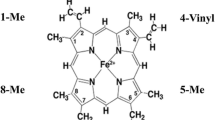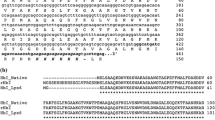Abstract
Fatty acid-binding protein from bovine liver but not from bovine heart binds hematin in a saturable manner with high affinity. This property is not confined to a particular isoform as both, pI 6.0- and pI 7.0 L-FABP, bind hematin similarly. In competition experiments hematin and oleic acid could replace each other demonstrating that they share at least parts of the same binding site. Common structural features, i.e. the presence of carboxylic groups and of hydrophobic carbon chains led to the hypothesis that both ligands interact similarly with L-FABP. This was supported by the decrease of binding affinity for either ligand upon modification with phenylglyoxal. Modification in the presence of fatty acid revealed the protection of one of the two arginines of L-FABP. By peptide mapping and Edman degradation Arg122 was identified as the counterpart of the fatty acids carboxylic group.
Similar content being viewed by others
References
Sweetser DA, Heuckeroth RO, Gordon JI: The metabolic significance of mammalian fatty-acid-binding proteins: Abundant proteins in search of a function. Annu Rev Nutr 7: 337–359, 1987
Spener F, Börchers T, Mukherjea M: On the role of fatty acid-binding proteins in fatty acid transport and metabolism. FEBS Lett 244: 1–5, 1989
Sacchettini JC, Gordon JI, Banaszak LJ: Refined apoprotein structure of rat intestinal fatty acid binding protein produced inEscherichia coli. Proc Natl Acad Sci USA 86: 7736–7740, 1989
Jones TA, Bergfors T, Sedzik J, Unge T: The three dimensional structure of P2 myelin protein. EMBO J 7: 1597–1604, 1988
Müller-Fahrnow A, Egner U, Jones TA, Rüdel H, Spener F, Saenger W: Three-dimensional structure of fatty-acid-binding protein from bovine heart. Eur J Biochem 199: 271–276, 1991
Zanotti G, Scapin G, Spadon P, Veerkamp JH, Sacchettini J: Three-dimensional structure of recombinant human muscle fatty acid-binding protein. J Biol Chem 267: 18541–18550, 1992
Xu H, Bernlohr DA, Banaszak LJ: Crystal structure of recombinant murine adipocyte lipid-binding protein. Biochemistry 31: 3484–3492, 1992
Schulenberg-Schell H, Schäfer P, Keuper HJ, Stanislawski B, Hoffmann E, Rüterjans H, Spener F: Interactions of fatty acids with neutral fatty-acid-binding protein from bovine liver. Eur J Biochem 170: 565–574, 1988
Vancura A, Haldar D: Regulation of mitochondrial and microsomal phospholipid synthesis by liver fatty acid-binding protein. J Biol Chem 267: 14353–14359, 1992
Vincent SH, Bass NM, Snider JM, Muller-Eberhard U: Are the rat liver cytosolic fatty acid-binding (L-FABP) and heme-binding (HBP) proteins identical? Biochem Arch 3: 443–451, 1987
Ockner RK, Manning JA, Kane JP: Fatty acid-binding protein: Isolation from rat liver, characterization, and immunochemical quantification. J Biol Chem 257: 7872–7878, 1982
Haunerland N, Jagschies G, Schulenberg H, Spener F: Fatty acid-binding proteins. Occurrence of two fatty acid-binding proteins in bovine liver cytosol and their binding of fatty acids, cholesterol, and other lipophilic ligands. Hoppe Seyler's Z Physiol Chem 365: 365–376, 1984
Vincent SH, Muller Eberhard U: A protein of the Z class of liver cytosolic proteins in the rat that preferentially binds heme. J Biol Chem 260: 14521–14528, 1985
Wilton DC: Studies on fatty-acid-binding proteins. The purification of rat liver fatty-acid-binding protein and the role of cysteine-69 in fatty acid binding. Biochem J 261: 273–276, 1989
Rasmussen JT, Börchers T, Knudsen J: Comparison of the binding affinities of acyl-CoA-binding protein and fatty-acid-binding protein for long-chain acyl-CoA esters. Biochem J 265: 849–855, 1990
Vork MM, Glatz JFC, Surtel DAM, van der Vusse GJ: Assay of the binding of fatty acids by proteins: Evaluation of the Lipidex 1000 procedure. Mol Cell Biochem 98: 111–117, 1990
Tipping E, Ketterer B, Christodoulides L, Enderby G: The interactions of heme with ligandin and aminoazo-dye binding protein A. Biochem J 157: 461–467, 1976
Yamasaki RB, Vega A, Feeney RE: Modification of available arginine residues in proteins by p-hydroxyphenylglyoxal. Anal Biochem 109: 32–40, 1980
Peeters RA, in't Groen MAPM, de Moel MP, van Moerkerk HTB, Veerkamp JH: The binding affinity of fatty acid-binding proteins from human, pig and rat liver for different fluorescent fatty acids and other ligands. Int J Biochem 21: 407–418, 1989
Buelt MK, Bernlohr DA: Modification of the adipocyte lipid binding protein by sulfhydryl reagents and analysis of the fatty acid binding domain. Biochemistry 29: 7408–7413, 1990
Author information
Authors and Affiliations
Rights and permissions
About this article
Cite this article
Börchers, T., Spener, F. Involvement of arginine in the binding of heme and fatty acids to fatty acid-binding protein from bovine liver. Mol Cell Biochem 123, 23–27 (1993). https://doi.org/10.1007/BF01076471
Issue Date:
DOI: https://doi.org/10.1007/BF01076471




